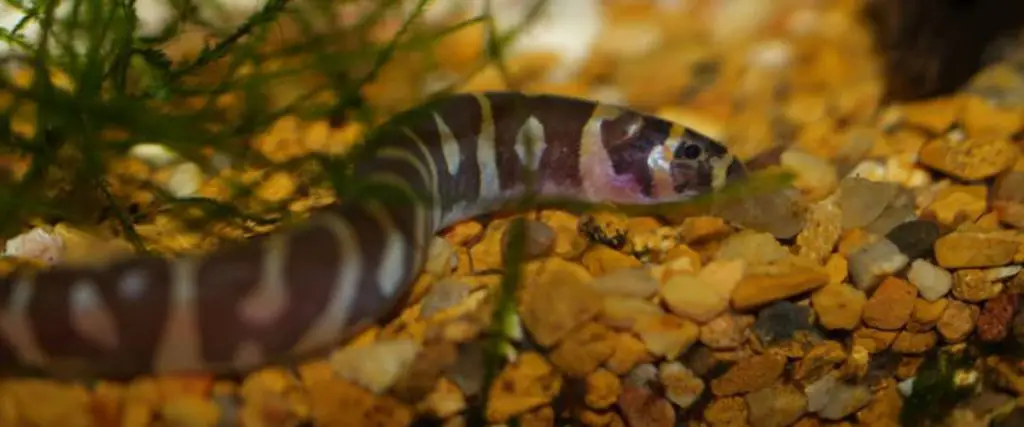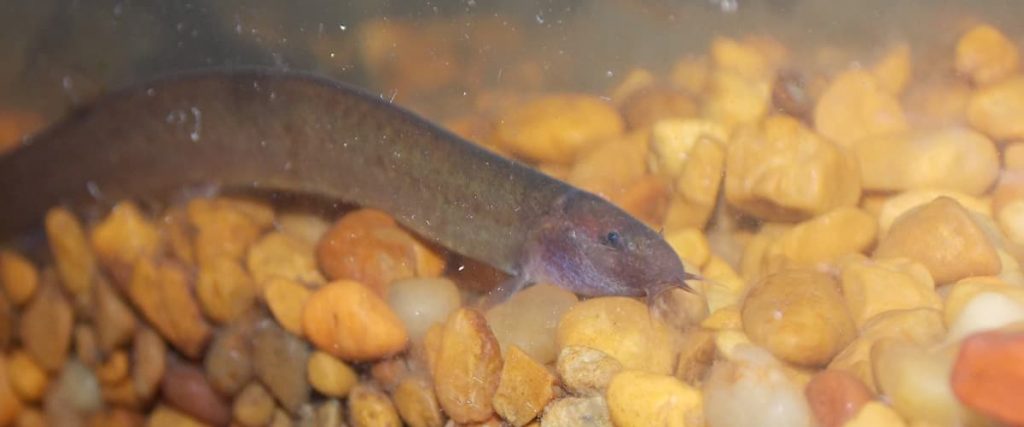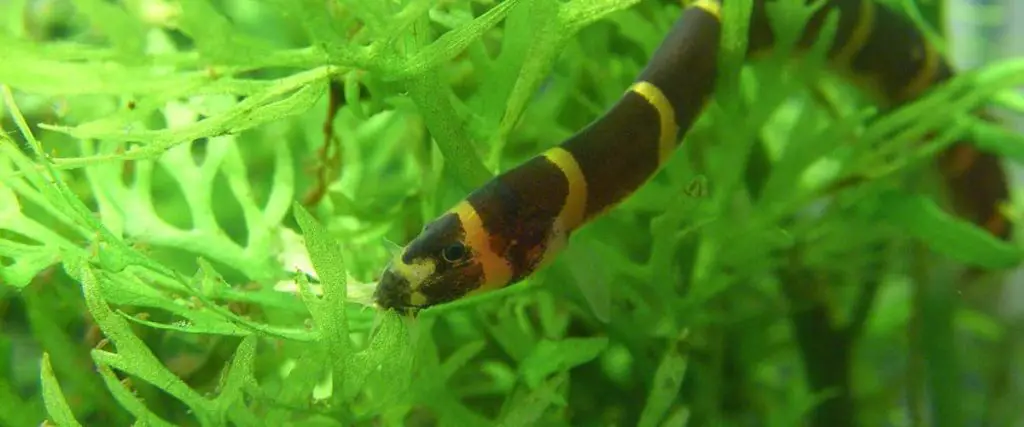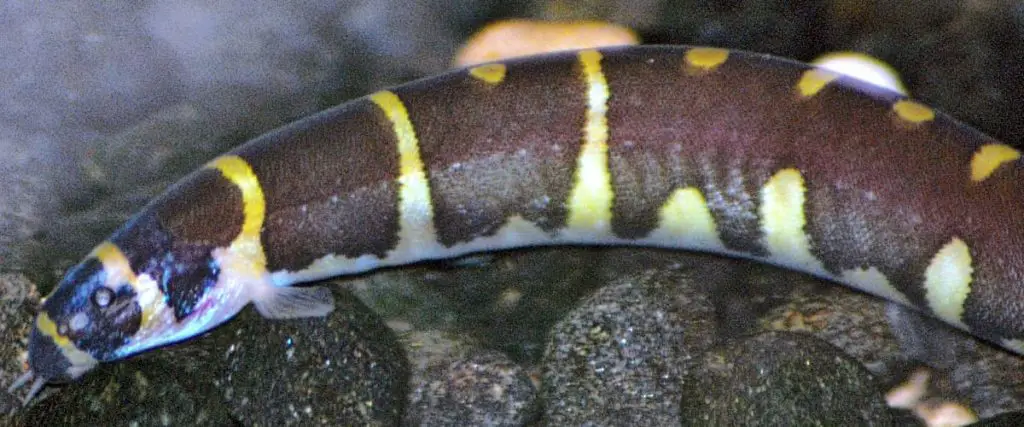For any freshwater aquarium setup where you need a cleaner fish, Kuhli Loaches are one of the top-recommended choices. They do require intermediate care experience, however, as they’re a little more delicate than say, a goldfish.
These are peaceful little fish that hang out at the bottom of your aquarium, vacuuming up the plant waste, excess food, and other things that most scavengers love. They’re sort of like the aquarium owl – scavenging all night throughout the tank, looking for food.
To help make sure you’re ready to care for these amazing little fish, let’s take a look at this Kuhli Loach care sheet.
It will answer your questions, like which fish make the best Kuhli Loach tank mates? What is the best Kuhli Loach tank size? How big is a kuhli loach full size? And what do Kuhli Loaches eat?
Let’s dive in.
Quick Intro to Kuhli Loaches
| Family | Cobitidae |
| Scientific Name | Pangio kuhlii |
| Other Common Names | Coolie Loach, Giant Coolie Loach, Leopard Loach, Prickly Eye, Banded Kuhli Loach, Striped Kuhli Loach, Cinnamon Loach, Black Kuhli Loach |
| Care Level | Intermediate |
Natural Habitat, Identification, and Where to Buy
Kuhli Loaches originate in Southeast Asia. They’re indigenous to the streams of Java, Borneo, Malaysia, Singapore, Thailand, and Sumatra. Their name comes from the word meaning “thorn eye,” thanks to the spines located beneath their eyes.
Kuhlis are one of two dozen different species of these eel-like fish in the Kuhli group. Most look species look very similar to each other – and often are confused for each other. The easiest way to tell them apart is through looking at their bands. Pangio Kuhlii have more bands that are darker in color than the Sumatra Kuhli, which is often confused with the Pangio.
The Pangio – the Khuli we’re looking at – remains the most popular Khuli Loach for fish keeping.
Kuhli Loaches have eel-like bodies that are slim, roundish in shape – tubular, you could say – and range in colors from yellow to pink. Their bands are dark brown and entirely or mostly encircle their bodies.
Because the various species do look so similar, it’s pretty easy to purchase the wrong species, so be sure to check the scientific name assigned to the fish you purchase. – And if you do happen to get the wrong fish, their care levels, dietary needs, and aquarium needs are similar enough that you shouldn’t have any issues. So, yes, that means Black Kuhli Loach care is almost indecipherable from Silver Kuhli Loach care.
When you are ready to buy your Khuli, you can find many reliable retailers that sell their loaches carefully to ensure aquarists are getting the preferred species. Some of those retailers include:

Optimal Water Conditions for Khuli Loaches
| Kuhli Loach Temperature | 75 – 86 degrees Fahrenheit |
| Water Flow Rate | Moderate to high |
| pH | 5.5 – 7.0 |
| Hardness | Up to 10 dGH |
Tank Setup
| Minimum Tank Size | 20 gallons |
| Optimal Tank Size | 35 gallons + 3-5 gallons per each additional Khuli |
| Optimal Tank Shape | Long, rectangular |
| Recommended Filter Type | Under gravel filter paired with hang on back filter for optimal filtration. They will swim into filters, however, if not properly shielded. |
| Extra Air Flow and How to Provide | The best way to add some added water and air flow for these guys – since they love a strong current – is through use of a powerhead, several air stones, and water pumps that offer directional adjustments. |
The most important thing that loaches need is a clean, well-oxygenated aquarium. They need fairly frequent water changes of about 30% weekly to keep them in optimal health. Weekly vacuum the gravel, remove excess waste, and get rid of excess food immediately after feeding.
They also need a tightly fitted lid, as they can be jumpers.
Creating the Landscape
The ultimate substrate setup for these guys is a sand and gravel mix. They live at the bottom of the aquarium primarily – though they will swim all over the tank at night when other fish are sleeping.
Khuli Loach décor is mostly based on your taste, apart from the substrate. The substrate should be smooth – never jagged – gravel combined with that sand for the clearest, cleanest setup. They do also like a bit of peat moss spread across the substrate – this emulates their natural environment.
We really cannot emphasis the importance of the right substrate with these guys enough. They are burrowers, so the substrate must be smooth and soft.
Khulis also do well with smooth large rocks and stones, driftwood – which should also be thoroughly treated before introducing into the tank – and roots. They’re extremely inquisitive, exploratory fish, so they love lots of caves, crevices, and hiding places to explore.
| Best Plants | Anubias, crypts, Java ferns, wisteria, dwarf Amazon swords, Cryptocoryne – almost any that float & almost any that are low-light plants |
| Best Lighting | Subdued to low light |
| Best Decorations | Gravel and sand mix – always avoiding anything potentially sharp – caves, ledges, hiding places, large smooth rocks, driftwood |
| Decorations to Avoid | Anything with sharp edges or points, hard gravel |
Physiological Considerations
| Maximum Kuhli Loach size | 4-inches |
| Rate of Growth | 2 years of age for full maturity |
| Lifespan | 10 years |
| Temperament | Peaceful |
| Preferred Tank Region | Bottom of the tank |
| Scale Thickness | Kuhli Loach do not have scales. |
| Gill Considerations | Despite their eel-like appearance, they are fish and do have gills. Many naturally have pink to reddish gills. |
| Swimbladder Considerations | They have somewhat susceptible swim bladders – so it’s important to keep an eye out for any appearance of bloating, distended bellies, etc. |
| Fin Shape Considerations | They have very small fins. |
Society
Kuhli Loaches are a very peaceful fish that primarily comes out at night. They’re quite shy – so if you keep only one of them, they will almost never come out of hiding. They need fellow loaches to feel comfortable and safe.
Khuli loach should be kept with other Khulis – a minimum of five Kuhli loach tank residents will help them feel secure and comfortable coming out for “company.” Interestingly, they are not schooling fish, despite being very social. They do need each other to avoid being overly stressed, too, by the way. Think of them as sort of an easily shy, extroverted introvert. They need each other – but not constantly.
Because they are so shy, you may well go without seeing your Khulis for days on end – unless you catch them out roaming at night – as they will burrow into the sand and hide for long stretches at a time. The more caves, rocks, and hiding places you provide, however, the less likely they are to hide in the sand.
They will likely only come out of hiding at night if there are multiple species in the fish tank. But they do get along well with a variety of fish species, even if they’re not best pals.
Some safe species of tank mates to house with your Khulis include:
- Other Khulis
- Harlequin Rasboras
- Oto Catfish
- Red-Tailed Black Sharks
- Bettas
- Red Cherry Shrimp
- White Cloud Mountain Minnows
- Zebra Danios
- Pearl Danios
- Neon Tetras
- Black Tetras
- Guppies
- Platys
- Blue Gourami
- Dwarf Gourami
- Honey Gourami
- Discus
- Apistogramma
- Corydoras
- Angelfish
- Clown loaches

Gender, Breeding, and Reproductive Considerations
It can be reasonably easy to tell male Khuli loaches from females. The adult male will have the first ray in his pectoral fin in a branched and thickened shape. The adult female is typically heavier bodied than the male – and larger than males. Plus, when they’re holding eggs, they’ll also be plumper than males. You’ll also be able to see the eggs through their very thin skin.
If you think you want to try Kuhli Loach breeding, you may be able to do it, but it can be rather difficult. You need very precise parameters to stand a chance.
Keep the low water levels with extremely dim lighting. Provide plenty of floating plants for the females to lay their eggs in. You’ll also need dense vegetation for spawning – which will, in fact promote spawning. Water hardness should be lowered and pH levels at 6.5.
Do everything you can to make your Khuli Loaches comfortable in their environment. The more comfortable they are, the more likely they are to spawn.
Khulis are also communal spawns, so it’s important to have them in with other Khulis if you want to increase the possibilities of spawning.
Plenty of food is required for spawning as well. Go with live foods for best results.
The other part that makes breeding them difficult is that the adult fish often eat the fry and the eggs.
Once those eggs are laid, remove the adults immediately if you have any hope of the eggs and fry maturing. For this reason, it’s recommended you introduce the adults into a breeding tank a while before you wish to induce breeding. Let the loaches become very comfortable in the breeding tank, and then alter the conditions to encourage spawning.
Eggs hatch approximately 24 hours after they are laid. You should feed the fry with brine shrimp or Infusoria or high-quality, commercially prepared fry food.
Nutritional Needs
Khuli loaches are omnivores, so they require a healthy, balanced diet of both protein sources and plant-based nutrients. Since they are scavengers, finding the right balance for their fed diet is incredibly important.
Naturally, Khulis eat things like mosquito larvae, bloodworms, and flies, along with plants found in their natural habitat of rivers in Asia.
The best Kuhli Loach food is going to be a combination of live food, prepared foods, and vegetables.
Like with all fish, it’s important to make sure that you’re feeding your Khulis the best quality fish food. Many companies produce high-grain content foods – and these should never be your choice for any fish. They don’t naturally eat wheat, corn, and soy in the wild – so feeding these ingredients to them at home can cause harm to your fish. These guys especially need grain-free foods, since they are prone to swim bladder issues.
Use a grain-free – or as low content as you can find – food source as their primary food, supplementing heavily with live foods, fresh vegetables, and freeze-dried or frozen foods.
It’s also incredibly important to make sure that the foods you do feed them are sinking. If they float, your Khulis won’t be able to eat properly, since they’re bottom dwellers.
| Best Sustenance Food Type | Low-grain/no-grain sinking pellets or flakes |
| Additional Food for Optimal Health | Microviers, Grindal, Artemia, Daphnia, freeze-dried bloodworms, insect larvae, brine shrimp and other small crustaceans, tubiflex, worms, salt shrimp, flies |
| Special Foods and Considerations for Best Color and Growth | Algae wafers and adding in fresh vegetables like zucchini, red peppers, cucumbers will improve their health and coloration. |
| When and How Often to Feed Fish Based on Life Cycle | You should feed your Khulis several times a day, though focus on nighttime and early morning feedings. This is when they naturally roam around looking for food |

Common Diseases and How to Avoid and Treat Them
The Kuhli Loach lifespan is up to ten or even fourteen years if they are kept healthy. However, as we’ve mentioned elsewhere, Khuli Loaches are not the easiest fish to keep in an aquarium at home.
One of the big reasons for this is their specific parameters for happy health – that low lighting can be killer for some plants and other fish! – but the other, and more important reason is that they are more susceptible to diseases than many other aquarium fish. It’s believed this susceptibility may well be due to the lack of scales on their bodies and heads.
It’s incredibly important to introduce your new Khulis to an aquarium with extreme care. They’re incredibly sensitive to chemicals, antibiotics, and other elements in the water. This is why filtration systems are so key to their survival and health.
If you notice one of your Khulis becoming ill, it’s important to immediately remove them to a separate hospital tank. And, because they’re so prone to illnesses, it’s best to keep a hospital tank around just about all the time to make sure you’re on the ball if any symptoms pop up.
Khulis need consistent water conditions and temperatures to ensure their health – sudden changes, colder water, et cetera will increase their likelihood of catching something nasty.
The most common condition to affect a Khuli is Ich. This is known as “white spot disease” and can be identified by – you guessed it! – white spots on your Khuli’s little body.
Ich is a parasite that attacks aquarium fish, but loaches are the first victims in most cases. If you have to treat your loach with any kind of medicine, their sensitivity requires the dose to be half of the normal dose or less.
Khulis are also very susceptible to something called Skinny Disease. This can be diagnosed reasonably easily – the loaches lose weight despite eating properly. This disease is caused by internal parasites that can be treated very carefully with antibiotics.
- Best Antibiotics: Quickcure – one of the few that can be given to loaches at full dose. Kanamycin, Nitrofurazone, Melafix, Praziquantel, Metronidazole, Levamisole, kosher salt
- Treatments to Avoid: Anything at all harsh, anything heavy. Only go with light doses until you see how your loach responds.
- Food Recommendations When Sick: Up the veggie and protein intake.
- Hospital Tank or Isolation Within the Community Tank Specifics: Absolutely necessary – Khulis should always be removed to a hospital tank to help them clear out any diseases.

3 More Things to Know About Kuhli Loaches
- Kuhli Loaches are extremely social, despite being very shy and rather timid.
- Kuhli Loaches may look like eels, but they’re actually scale-less fish.
- Kuhli Loach eggs are green in color and hatch in only 24 hours once they’ve been laid.


Very well informed article on kuhli s. Had them when I was a kid in the Sixties . Everything there is spot on. Thank you.